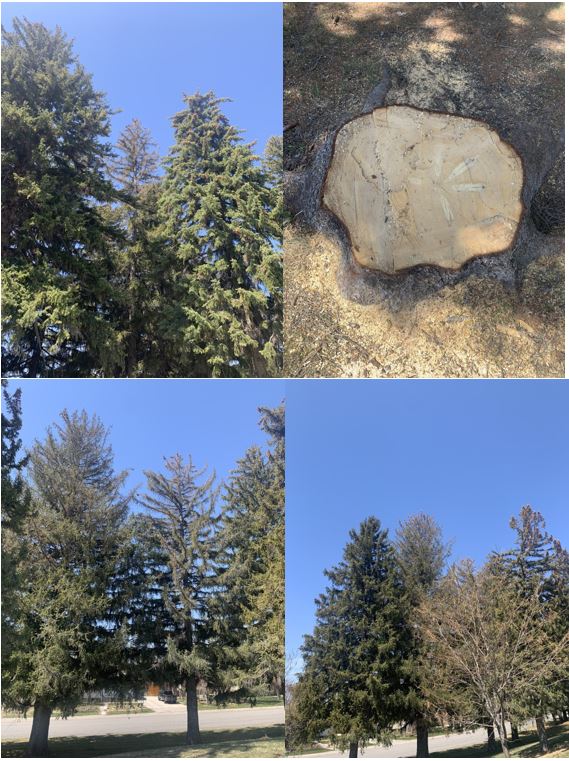Ask an Expert
Question from Unknown, Utah (received 3/31/21) -
Dear Dr. Kuhns,
I have some trees on my property that appear to be dying. Over the last year, we have had to cut a couple of them down, and others continue to show similar symptoms. I have attached some photos of the trees in question, and I am hoping you may be able to come help us determine what is causing these trees to decline.
Answer from Dr. Mike Kuhns, USU Extension Forester and Professor (sent 4/02/21) -
Most of the trees we looked at, and the ones with the most problems, were Norway spruces. The tree that had died and that had recently been removed was a Norway spruce that was several feet in diameter and about 85 years old. A photo is attached of a section I took from the stump that includes bark and some wood and growth rings from the last several decades. It is clear to me after looking at that tree and the similar ones around it (mostly on the west edge of the property) and at the growth ring patterns that inadequate water was the main problem for that tree and is the main problem with the other spruces that do not look healthy elsewhere on the property. As I drove there and elsewhere in the city during my visit, I saw many other large spruces that had similar problems on private property, so many people are underwatering their spruces and other species.
The unhealthy trees have sparse crowns with much less foliage (needles) on shorter twigs than a healthy tree would have. They also are retaining their foliage for a shorter time than a healthy tree would. Spruces keep their needles for 6 to 10 years before they finally die and fall off. The less healthy trees I saw were retaining their needles for half that long. The cause is stress and, on these trees, probably water stress. Having less needles is caused by lack of water and it means that the tree makes less food for itself because the needles are where photosynthesis occurs. Less food means less stem and root growth. Also, some species, including spruces, are more susceptible to successful attack by insects and diseases when they are stressed. Spruces that are healthy can produce more resin, which takes a lot of food to make but it can push bark beetles out. When we went to examine the recently felled trees, we peeled off the bark and saw many examples of feeding galleries made by spruce ips beetles in the cambium and phloem (inner bark). This feeding would have girdled and killed the portions of the trunks that it occurred in. Though drought stress can weaken and eventually kill these trees directly, the insect attacks are more successful in drought stressed trees.


You can see on the attached photo a growth ring pattern that could be caused by inadequate irrigation and that would be made worse by insect attack. For the last 3 years or so the most recently made growth rings (nearest the bark) are fairly narrow, the rings formed from year 4 to 7 are fairly wide, and the rings older than that are fairly narrow for several decades before that. We all talked about what the growth ring pattern could mean to the tree's health. It was mentioned that for several years that coincide with the wider growth rings the property, and particularly that area on the west side of the property, were heavily watered and that water availability was almost unlimited, even to the point of it causing turf problems from overwatering. Then more recently the irrigation has been cut way back to the point of it starting to affect tree health.
My recommendation is that, if you want to save those large trees that have been declining and dying, you will need to water them more; maybe not as heavily as they were watered a few years ago, but certainly more than they are getting now. I think that most of the declining trees can recover with more irrigation, but the worst ones may not. You could consider spraying the worst ones to slow or stop the successful attacks of the bark beetles. There are several good web resources available from USU and elsewhere on dealing with these insects:
If more water is not available, you will need to consider planting more drought hardy trees. Good choices are ponderosa pine and other pines and junipers. White or concolor fir would also be a good choice. To learn more about good tree species I suggest that you go to our Tree Browser website.

